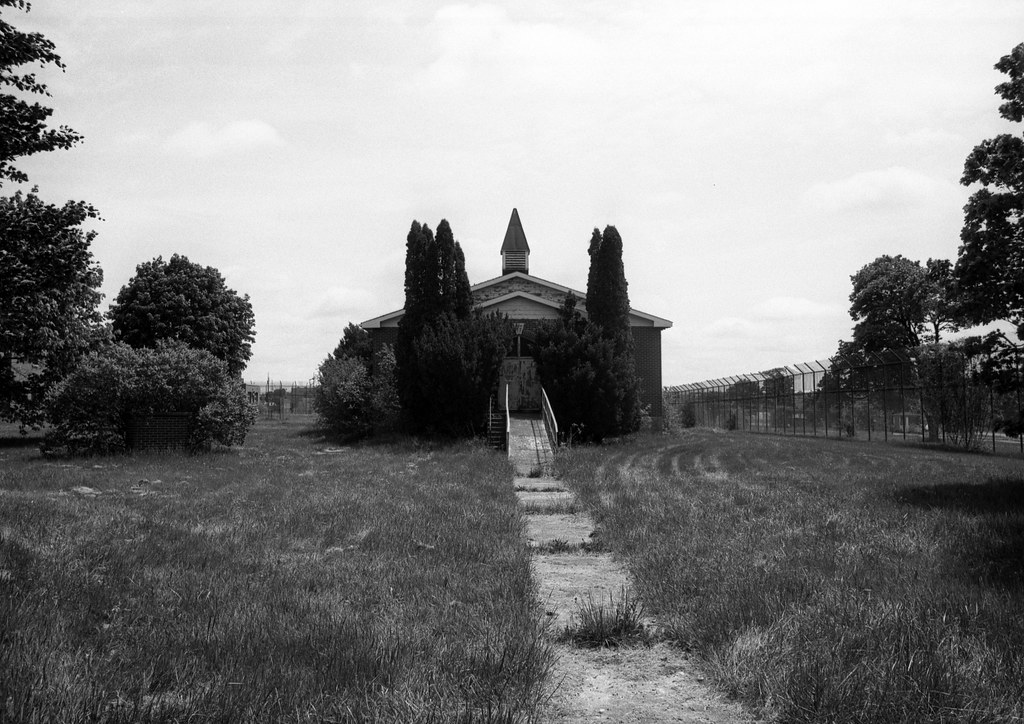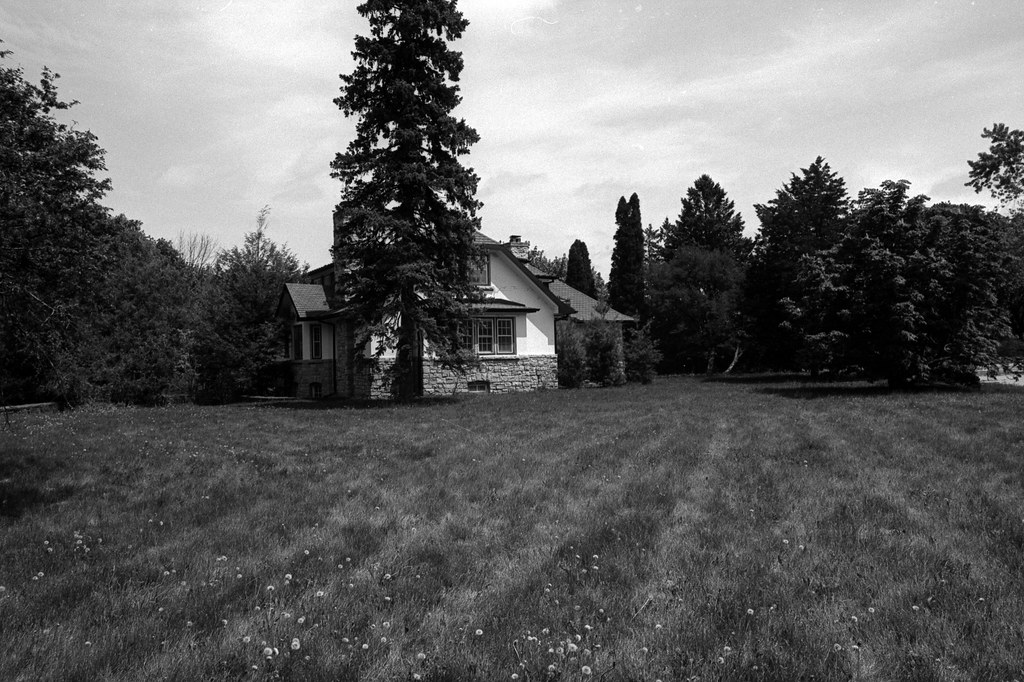I can always remember seeing this massive building off in the distance going to and from Guelph when visiting my Opa. When I first got to see the building up close, it wasn’t as big as I thought it was. In fact, it was rather small. I’m talking about the former Guelph Jail. I’ve known it has been abandoned and closed for some time, and back in the day, I always contemplated trying to sneak in under cover of darkness. But things never aligned properly, I did get a chance to see inside during the one Guelph Doors Open event I attended in 2009. The walkthrough was rather restrictive, and the event committee had put a blanket no interior photography rule over every site (although some sites ignored that one), so all I had to show for the trip was a bunch of exterior shots while waiting in line. But earlier in the year, I happened across an online event on my Facebook feed about an online talk about the Yorklands, the property on which the jail sits and how a local community group has opened it up as public greenspace. I jumped on the event and attended through Zoom and discovered that it is perfectly legal to walk onto the property (the jail is off-limits, but you can get close, and I marked it down as a theme for this project. And though it has been delayed, I took the chance and visited the Victoria Day long weekend. Oddly enough this is the fourth such prison site that I have visited with a shared history of early 21st Century shut down, the other three being Kennedy House, Millbrook and Rideau.

Nikon FM – AI Nikkor 28mm 1:3.5 – Fomapan 100 @ ASA-100 – FA-1027 (1+14) 9:00 @ 20C
The site of the Guelph Correctional Centre has a long history tied to the early settlement of the region. The site’s use as a reformatory starts in 1909. William Hanna begins a wide-reaching system of prison reforms to modernize Ontario’s correctional system. By the 20th Century, most prisons in Ontario pre-dated Canadian Confederation and had, rightly so, earned a rather poor reputation. While there were smaller regional jails, most were centred in major population centres. A new idea of reforming criminals rather than simply punishing them became clear and aimed to reshape the entire penal system across Canada. The government purchased the land and would use prison labour to start construction in 1910 on the Ontario Reformatory. The new prison would be based on designs by John Lyle, and materials would be quarried locally on the site. Construction would continue from 1911 to 1915, following the Beaux-Arts style. The new institution housed prisoners and put them to work through manufacturing and farming, both of which were in full operation by 1914. By 1916 some six hundred inmates were housed in Guelph. But the increase in hostilities during World War One forced the government to turn the facility into a Military Hospital starting in 1917. By the end of the war and the return of Canadian troops in 1919, the facility housed some 900 veterans of the Great War. In 1921 the facility returned to housing prisoners. The Guelph institution’s workshops and farms would produce enough food to support its own prison population, and surplus sent out to smaller jails that lacked the property to operate farms. Blankets, metal and wood products would also come out of the prison, which was used to improve local parks through crushed stone and benches. Through the mid-century, the prison flipped through various uses of punishment and more reform-oriented attitudes. Sadly the prison was subject to riots, the largest taking place in 1952. Resulting in a violence intervention and staff training school, including the use of firearms being placed on the property. The train would come in handy as other prisons started to have riots in the second half of the 20th Century. In the 1960s, the prison farm at Guelph would hold public exhibitions, and several community efforts and service clubs would help run recreational programs. Sadly the budget cuts and changes in the correction system would end the Guelph Prison farm in 1972. However, that would not be the end of prison work on the farm, which continued in a trout processing and packaging plant that opened in 1982. The 1990s brought further reform to the prison system, prisoner labour and many additional rehabilitation programs were cut during that decade. There also was the move to larger super prisons rather than smaller regional units. Guelph was among those prisons to close in 2001, with the official decommissioning taking place in 2002. The heritage value would be realised in 2006, and efforts were undertaken to sell the property for adaptive reuse, and a decade later, work began to prepare the old jail for sale. This is where the Yorkland Green Hub stepped in with plans for the former prison grounds. Yorklands Green Hub aims to turn the property into a one-of-a-kind hub focusing on developing an education centre among the scenic streams, ponds, meadows, and trails. While their work continues, the ground remains open for the public to use the green space, and they also offer tours and online seminars on the property.

Nikon FM – AI Nikkor 135mm 1:2.8 – Fomapan 100 @ ASA-100 – FA-1027 (1+14) 9:00 @ 20C
Nikon FM – AI Nikkor 28mm 1:3.5 – Fomapan 100 @ ASA-100 – FA-1027 (1+14) 9:00 @ 20C
It would be easy to focus my image choices on the prison itself as it was the main draw to the site. In comparison, I couldn’t actually get inside the prison itself, although I should see about arranging access. I did get a handful of images of the landscape options at the Yorklands site. My main draw was the prison, which makes up all the images I include in today’s post. The first one being the administration building; while not the first building you will see on the site, it is the one that continues to draw you up the long driveway into the site. Having the longer lens, I captured the interesting inclusion of the Ontario Coat of Arms. And, of course, the main prison tower at the centre of the complex. The cornerstone is also included because it includes the premiere at the time, Whitney, who has another abandoned government building in his name in Toronto. While I did try to find my way around the fence line by walking around the one side, there were no gaps, but I did get an idea of the scale of the property. So I ended up having to shoot the chapel through the chainlink fence and including the warden’s house, which was not as grand as I thought.

Nikon FM – AI-S Nikkor 50mm 1:1.8 – Fomapan 100 @ ASA-100 – FA-1027 (1+14) 9:00 @ 20C
Nikon FM – AI Nikkor 28mm 1:3.5 – Fomapan 100 @ ASA-100 – FA-1027 (1+14) 9:00 @ 20C
Given the wide range of photographic opportunities, I returned this week to having a three-lens kit with me. Going with my 28mm, 50mm, and 135mm. The reason was to get both wide-angle and detail shots, especially when some shots were out of range of getting in closer with my feet; I had to get in closer with optics. The day was nice and bright, and I probably could have gotten away with having a filter, but with all the lens switching and the desire to get faster shutter speeds (1/250″ with the 135mm), I decided that the filter was better off on my Nikon FA shooting a faster film. I shot the Fomapan at its box speed of ASA-100 and developed it in FA-1027; I had developed a roll a couple of weeks ago using this developer for the Hasselblad 503cx review and loved the results in 120, so I decided to give it a go with 35mm and came up with equally excellent results.

Nikon FM – AI Nikkor 28mm 1:3.5 – Fomapan 100 @ ASA-100 – FA-1027 (1+14) 9:00 @ 20C
Nikon FM – AI Nikkor 28mm 1:3.5 – Fomapan 100 @ ASA-100 – FA-1027 (1+14) 9:00 @ 20C
Next week we’re heading back into the Halton region, and exploring a historic farm north of Milton but also travelling another section of the Bruce Trail.